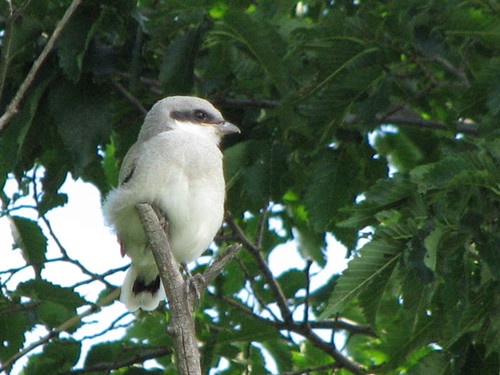We've just returned from a great long weekend camping trip to Kinbrook Island Provincial Park near Brooks, which is about 200km south-east of Calgary. The park is on the east shore of a large reservoir, Newell Lake, and the campground is basically an island covered in poplar trees and surrounded by marsh. The existence of these three habitats together in the middle of vast prairie grassland is, as you can see below, a real bird magnet.
In the campground there were several species of flycatcher ranging from the easily identified and bold to the tricky and hyperactive. (As usual all photos in the post are click to enlarge!)
 |
| Western Kingbird, Tyrannus verticalis |
 |
| Eastern Kingbird, Tyrannus tyrannus |
 |
| Least Flycatcher, Empidonax minimus - OK, I heard several Least Flycatchers, this bird was close by, and it looks like a Least Flycatcher but those empids are tricky! |
A birding highlight of the weekend came while I was washing breakfast dishes. There was a flurry of activity in the understory. A group of 4 male
Brown-headed Cowbirds chasing one female were displaying to each other on branches and, ultimately, on the grass about ten yards in front of me.
 |
| Brown-headed Cowbird, Molothrus ater |
 |
| Brown-headed Cowbird, Molothrus ater |
There are nice walks (if you aren't freaked out by bugs like our 3 year old!) around the marshes, including an interpretive trail around the northeast area that was a little long for our crew of preschoolers. The dominant species in this area is
Red-winged Blackbirds, but spaced out among these territorial birds were
Yellow-headed Blackbirds and a large number of
Marsh Wrens.
 |
| Marsh Wren, Cistothorus palustris |
 |
| Yellow-headed Blackbird, Xanthocephalus xanthocephalus |
During one of these walks we bumped into a group of birders doing the
13th Annual Brooks Species Count. They commented on the lack of shorebirds, an observation supported throughout the weekend and the drive back to Calgary (one yellowlegs, one snipe, and three large shorebirds on a far off muddy field was all I saw). I was generally surprised by the lack of birds on the main bodies of water in the park but along with the usually half dozen species of duck we did see
Red-necked Grebes,
Forster's Tern, and some
American White Pelican.
 |
| American White Pelican, Pelecanus erythrorhynchos, displaying breeding season "horn" |
This relative lack of species on the open water was entirely compensated for by the continual displays of flycatchers,
Tree Swallows,
Yellow Warblers, blackbirds, sparrows, and ever-friendly
American Robins around the campsite. I would highly recommend this campsite as a destination for the birding-inclined camper or any family looking for a prairie getaway.
In total, 48 species were seen on the weekend getaway and a birder working the area in a more focused way would have no trouble finding many more. For those interested here's the list of species seen either at Kinbrook or in the immediate Brooks area:
| Canada Goose | Branta canadensis |
| American Wigeon | Anas americana |
| Mallard | Anas platyrhynchos |
| Blue-winged Teal | Anas discors |
| Northern Shoveler | Anas clypeata |
| Northern Pintail | Anas acuta |
| Redhead | Aythya americana |
| Lesser Scaup | Aythya affinis |
| Ruddy Duck | Oxyura jamaicensis |
| Red-necked Grebe | Podiceps grisegena |
| American White Pelican | Pelecanus erythrorhynchos |
| Northern Harrier | Circus cyaneus |
| Swainson's Hawk | Buteo swainsoni (on nest) |
| Red-tailed Hawk | Buteo jamaicensis |
| American Coot | Fulica americana |
| Yellowlegs sp. | Tringa sp. |
| Wilson's Snipe | Gallinago delicata |
| Ring-billed Gull | Larus delawarensis |
| Forster's Tern | Sterna forsteri |
| Rock Pigeon | Columba livia |
| Mourning Dove | Zenaida macroura |
| Great Horned Owl | Bubo virginianus (adult with two fledglings) |
| Northern Flicker | Colaptes auratus |
| Least Flycatcher | Empidonax minimus |
| Western Kingbird | Tyrannus verticalis |
| Eastern Kingbird | Tyrannus tyrannus |
| Black-billed Magpie | Pica hudsonia |
| American Crow | Corvus brachyrhynchos |
| Common Raven | Corvus corax |
| Tree Swallow | Tachycineta bicolor (on nest - tree cavity) |
| Barn Swallow | Hirundo rustica |
| Marsh Wren | Cistothorus palustris |
| American Robin | Turdus migratorius (on nest) |
| Hermit Thrush | Catharus guttatus |
| European Starling | Sturnus vulgaris |
| Yellow Warbler | Dendroica petechia |
| Common Yellowthroat | Geothlypis trichas |
| Chipping Sparrow | Spizella passerina |
| Clay-colored Sparrow | Spizella pallida |
| Vesper Sparrow | Pooecetes gramineus |
| Song Sparrow | Melospiza melodia |
| Red-winged Blackbird | Agelaius phoeniceus |
| Western Meadowlark | Sturnella neglecta |
| Yellow-headed Blackbird | Xanthocephalus xanthocephalus |
| Brewer's Blackbird | Euphagus cyanocephalus |
| Brown-headed Cowbird | Molothrus ater |
| Baltimore Oriole | Icterus galbula |
| House Sparrow | Passer domesticus |

























